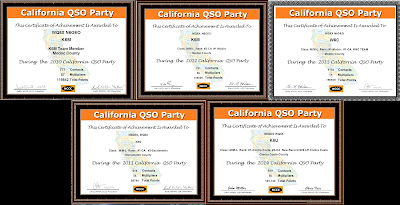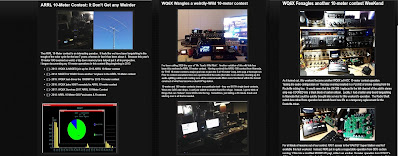The 3rd weekend in December brings us a handful of 24-hour radiosport contest events
from around the world, beginning with the OK Dx RTTY and Canadian Winter Contests and
ending with the Croatian Cw contest and Stew Perry 160-meter Top Band Challenge (TBC).
- [X] -
OK Dx RTTY Contest
- [X] - RAC Winter Contest
- [X] - Croatian Cw Contest
- [X] - Stew Perry Top Band Challenge
Tuning around the bands with the FT-2000, virtually no RTTY was heard.
While I heard plenty of RTTY remotely, the WA6TQT station has no capability
to do RTTY at this time. That left 3 contests to run during approximately 38 hours.
Canadian contests have become a favorite the last several years. My only wish is that they
were longer than 24 hours. The RAC Winter GiG allows any station to contact any other station
for 2-points. However, if that station happens to also be Canadian, that QSO is worth 10-points.
If that Canadian also happens to be running an RAC station, (VY2RAC, VE2RAC, VE6RAC, etc.)
that QSO is worth 20-points. With new multipliers on each band-mode, I made it a point to activate
all bands on 160 - 10 meters, except I was too lazy to setup the microphone audio for 160,80 & 40
on Friday evening.
Space-WX condx. were AWEsome the entire weekend; almost TOO GooD. From Anza, signal locations were actually the REVERSE of what is normally expected - signals from Europe often sounded like they were next door, while close-in stations had a "flutter" (as if they had travelled
a polar route).
It would seem that "Intentional QRM" came in the form of careless Ssb. While attempting to run
a frequency in the 9ACW contest, 7031.31 was suddenly surrounded by a cluster of Ssb stations, presumably Indonesian sounding, altho 04:33z is a little early for propagation to Asia on 40-meters.
Earlier in the day while looking for Canadian stations on 20-meter Ssb, I came across some rock music playing in the background behind VE6AO's run frequency. I expect that kind of nonsense
on 75-meter Ssb in the evening, not 20-meters during the last 45 minutes of the RAC contest.
Like the OK-RTTY contest, I nearly didn't find time for the Croation 9ACW contest. Tuning around
40-meters after the RAC contest, numerous EU spots were spotted, which quickly became signals which I could hear and eventually work. In between runs in the Stew Perry 160 contest, WQ6X managed 69 Cw QSOs, allowing the submission of an SOA-40 log; ironically, exactly 69 QSOs
made it to the SP-160 log.
Looking at past
Top
Band
Challenge scores, it seemed that there was a dearth of QRP entries. Having access to a full-size (albeit "crippled") tri-square array delivered the 5-watt signal as far as: KL7/VE7/VE6, K1/K3/K4, and even PJ2/ZF9 & KH6 - NoT bad for running QRP power. Of course, it required a clear run-frequency to make that happen, requiring that I switch run frequencies frequently.
Because each of the 3 contests were dramatically different, the real challenge was to leverage the
WA6TQT antenna system to deliver maximum performance running low power (100-watts) and QRP power (5-watts), demonstrating the importance of using highly efficient signal radiators. With a dipole or vertical, it would require over 800+ watts to accomplish what was accomplished with 5 & 100 watts.
When it was all over, it would seem that WQ6X was top score for W6 in all 3 contest events.
In the RAC GiG it would seem that WQ6X took 2nd-place for the USA. When you consider
that I was ad-HOC'ing things all the way, I am pleased with the ending results.
DiD YOU work the RAC, 9ACW or SP-160 contests?
Is WQ6X in YOUR Log?







%20+%20Power%20Supply.Jpg)

%20+%20Spectrum.Jpg)
.Jpg)





.Jpg)





.Jpg)













.Jpg)












.Jpg)
